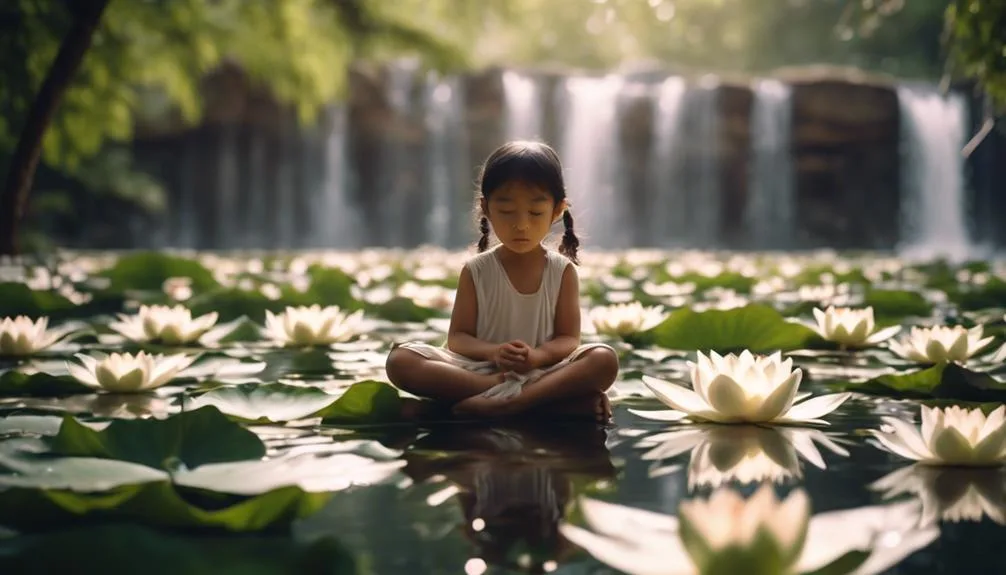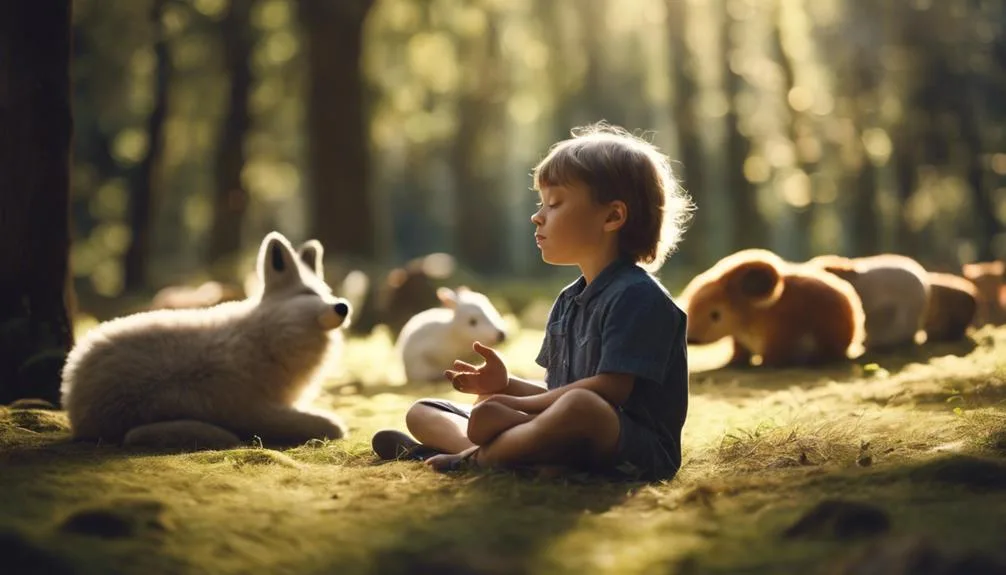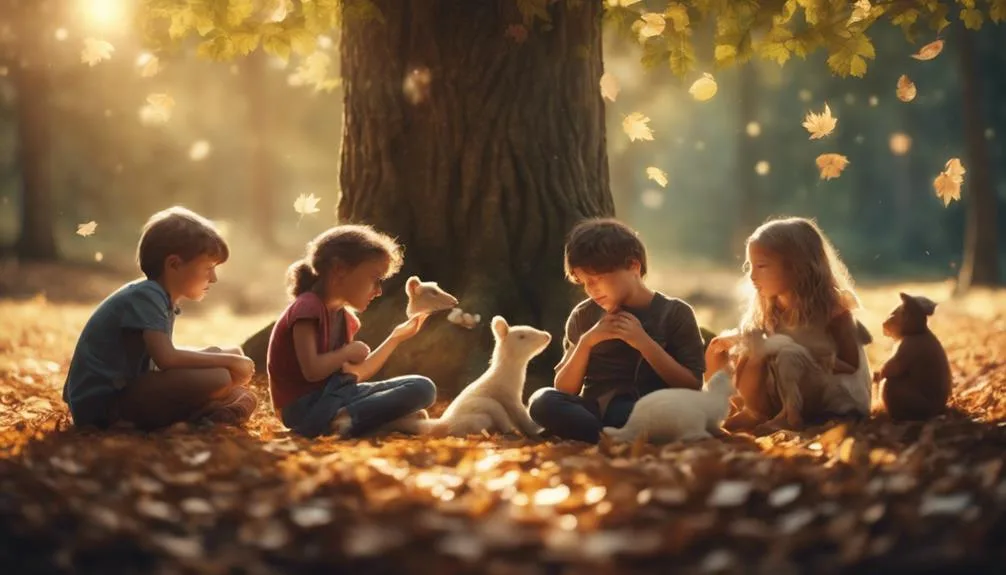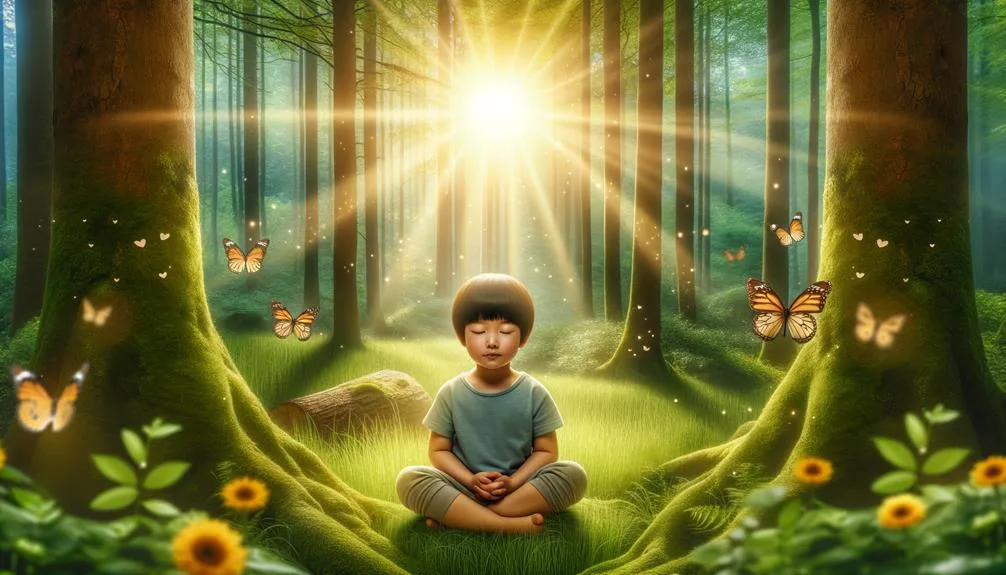In the contemporary landscape of childhood, characterized by its high demands and rapid pace, mindfulness meditations for kids stand out as a vital tool for fostering a sense of inner peace and emotional equilibrium.
These practices, which range from simple breathing techniques to more elaborate guided relaxations, offer not only a reprieve from the daily tumult but also equip young minds with the skills necessary to navigate their emotional and cognitive landscapes with greater ease and awareness.
As we explore the various facets of mindfulness tailored for children, one is compelled to consider the transformative potential these techniques hold in nurturing well-rounded, resilient individuals.
Key Takeaways
- Mindfulness meditations enhance children's emotional regulation and stress management skills.
- Guided mindfulness practices, like the Ten Minute Meditation, introduce kids to thought awareness in an accessible manner.
- Quick 5-minute mindfulness exercises offer a solution for busy schedules, promoting brief moments of peace and calm.
- Storytelling and imaginative meditations engage children's minds, fostering relaxation alongside creativity and a sense of adventure.
Breathing Techniques for Kids
Breathing techniques for kids, when taught correctly, can serve as a powerful tool to enhance their ability to manage stress and improve their overall well-being. By integrating mindful breathing into their daily routine, children learn to pause and center themselves, creating a sense of calm in moments of chaos or discomfort.
These relaxation exercises, when practiced regularly, not only aid in emotional regulation but also contribute to better concentration and sleep patterns. The beauty of these techniques lies in their simplicity and accessibility, allowing kids to use them anytime and anywhere.
Bedtime Sleep Meditations
In the tranquility of the night, bedtime sleep meditations serve as a gentle bridge guiding children from the day's adventures into a peaceful night's rest. Integrating a sleep routine that includes bedtime relaxation can transform the night for a child, shifting from a time of restlessness to one of serene slumber.
| Benefits | Visualization |
|---|---|
| Enhances Sleep Routine | Sleepy Sloth in Dreamland |
| Promotes Bedtime Relaxation | Stars Twinkling in Night Sky |
| Improves Overall Well-being | Gentle Waves of Dreamy Ocean |
Guided Relaxation Practices

Shifting focus to Guided Relaxation Practices, it becomes evident how these techniques offer children a unique pathway to achieve calmness and serenity, complementing their bedtime routines for a more restful sleep.
Among these practices, mindful coloring emerges as a standout tool. It allows children to express themselves creatively while focusing on the present moment, thereby reducing stress and anxiety.
Similarly, nature walks serve as an invaluable resource, encouraging kids to engage with their surroundings in a mindful way. This direct connection with nature not only fosters a sense of peace but also enhances their appreciation for the environment.
Both activities are simple, yet profoundly effective in guiding children towards a state of relaxation and mindfulness, proving to be essential components of their emotional well-being toolkit.
Mindfulness and Focus Exercises
Exploring mindfulness and focus exercises offers children a powerful tool to enhance their awareness and concentration, helping them navigate their emotions and thoughts with greater ease. Incorporating activities such as mindful coloring and focus games into a child's routine can significantly improve their ability to pay attention and remain present in the moment. These exercises not only foster a sense of calm but also enhance cognitive skills.
- Mindful coloring encourages creativity while promoting focus.
- Focus games sharpen attention and problem-solving skills.
- Breathing techniques integrate calmness into daily activities.
- Visualization practices boost imagination and concentration.
- Guided story sessions enhance listening skills and mindfulness.
Quick Mindfulness Sessions

Building on the foundation of mindfulness and focus exercises, quick mindfulness sessions offer a practical and time-efficient way for children to further develop their emotional regulation and calmness. These brief interludes into mindfulness can be seamlessly integrated into a child's daily routine, making the practice more accessible and less daunting.
Mindful coloring, for instance, combines the creativity of art with the focus of meditation, allowing kids to express themselves while finding a moment of peace. Similarly, nature walks encourage children to engage with the environment mindfully, observing the detail and beauty in the world around them.
These activities not only provide a break from the digital world but also cultivate an appreciation for the present moment, fostering a sense of inner tranquility.
Visualization Meditation Methods
Delving into the realm of visualization meditation methods offers children a unique opportunity to enhance their imagination and promote emotional well-being through guided imagery exercises. These practices involve creative visualization and calming imagery, allowing kids to embark on peaceful inner journeys that foster a sense of tranquility and happiness.
- Creative Visualization: This method encourages children to picture positive outcomes, fostering optimism.
- Calming Imagery: Utilizes serene scenes from nature or imaginary places to induce relaxation.
- Guided Imagery: An adult leads the meditation, describing vivid scenarios for children to visualize.
- Focus on Breathing: Integrates visualization with deep breathing to enhance calmness.
- Sensory Engagement: Encourages children to imagine not just seeing but also feeling, hearing, and touching within their visualized environment.
These techniques are essential tools for aiding children in managing stress and anxiety, enhancing their emotional regulation, and boosting their creative thinking skills.
Storytelling Meditation Techniques

Storytelling meditation techniques harness the power of narrative to soothe the mind, offering a unique pathway to relaxation and emotional well-being for children. These methods blend the art of creative storytelling with mindful storytelling, inviting kids into a world where calm and peace are the main characters. By engaging their imagination, children learn to navigate their feelings and thoughts in a supportive, gentle environment.
| Technique | Age Group | Benefits |
|---|---|---|
| Fairy Tale Meditation | 4-7 | Enhances creativity, instills calm |
| Adventure Quest Relaxation | 8-12 | Builds focus, encourages exploration |
| Nature Story Calm | All ages | Promotes environmental mindfulness |
| Hero's Journey Calm | 6-10 | Fosters resilience, self-esteem |
| Night Sky Story | All ages | Supports relaxation, sleep readiness |
This approach offers a compassionate, understanding pathway to mindfulness that resonates with children's love for stories.
Imaginative Meditation Activities
Leveraging the foundation laid by storytelling meditation, imaginative meditation activities offer children a dynamic avenue to explore their creativity and foster a deep sense of calm. These activities encourage kids to embark on imaginary adventures and engage in creative visualizations that not only enhance their imaginative capabilities but also promote relaxation and mindfulness.
- Imaginary Journeys: Visualizing fantastical worlds or scenarios.
- Creative Characters: Imagining interactions with unique characters.
- Nature Quests: Exploring serene natural landscapes mentally.
- Object Focus: Visualizing and transforming objects in their mind.
- Dream Crafting: Encouraging kids to create and control their dream stories.
Through these practices, children learn to harness the power of their imagination, leading to improved focus, creativity, and inner peace.
All-Age Meditation Practices

Meditation practices suitable for all ages offer a universal path to tranquility and mental clarity, opening the door for family members of every generation to embark on a journey of mindfulness together. These moments of family mindfulness and child relaxation are not just activities; they are foundations for lifelong peace and understanding.
| Age Group | Practice Type | Benefit |
|---|---|---|
| Toddlers | Breathing Exercises | Enhances calm and focus |
| Children | Guided Imagery | Stimulates creativity |
| Adults | Mindfulness Meditation | Improves mental clarity |
Integrating these practices into daily routines promotes a culture of mindfulness that benefits everyone in the family. It's about creating a shared experience that encourages emotional connection and mutual support.
Frequently Asked Questions
How Can Mindfulness Meditation Impact a Child's Academic Performance and Attention Span in School?
Mindfulness meditation can significantly enhance a child's academic performance and attention span by improving sleep quality and facilitating stress reduction, creating a more focused and relaxed state conducive to learning and cognitive development.
Are There Any Mindfulness Meditation Techniques Specifically Designed to Help Kids With ADHD or Other Attention Disorders?
Yes, mindfulness meditation techniques tailored for children with ADHD incorporate breathing exercises and sensory activities. These methods aim to improve focus, reduce impulsivity, and enhance overall well-being, offering practical support for attention management.
Can Mindfulness Meditation Practices Be Integrated Into a Classroom Setting, and if So, How?
Yes, mindfulness meditation practices can be seamlessly integrated into the classroom setting through teacher training and cultivating a supportive classroom environment, fostering concentration, calmness, and emotional regulation among students.
What Are the Long-Term Benefits of Starting Mindfulness Meditation Practices at a Young Age?
Initiating mindfulness meditation from a tender age fosters stress reduction and builds emotional resilience. These practices equip children with tools for life, enhancing their ability to navigate challenges with grace and equanimity.
How Can Parents and Educators Measure or Observe the Effectiveness of Mindfulness Meditations on a Child's Emotional and Psychological Well-Being?
To evaluate mindfulness meditations' impact on children, parents and educators can use behavior tracking and encourage emotional journaling. These methods provide insights into emotional and psychological well-being, fostering a supportive and understanding environment.
Conclusion
In the labyrinth of life's challenges, mindfulness meditations serve as a lighthouse for children, guiding them toward a harbor of tranquility.
By embracing techniques such as breathing exercises, bedtime meditations, and imaginative journeys, young minds learn to navigate the tumultuous waters of emotions and thoughts with grace and ease.
This beacon of mindfulness not only illuminates the path to inner peace but also cultivates a garden of well-being, concentration, and emotional balance, enriching the soil of their developing minds for a lifetime.

